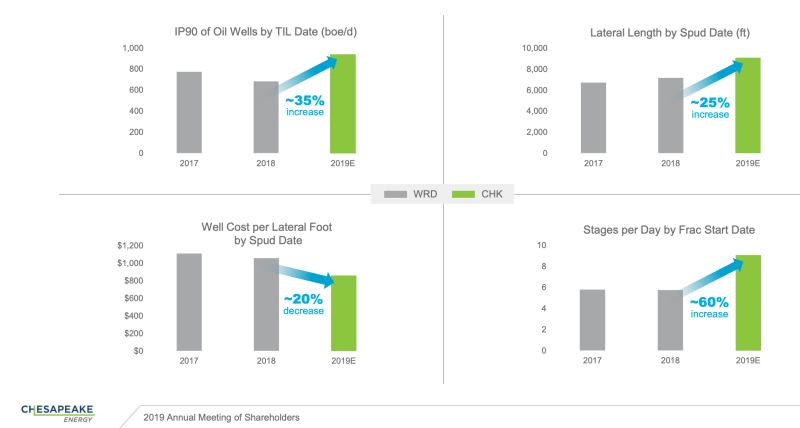
Chesapeake sees its net 470,000-acre position in Texas’ Brazos Valley and 213,000-acre position in the Powder as oil growth engines. (Source: Shutterstock.com)
Oklahoma City-based Chesapeake Energy is perhaps best known for its gas assets. But the company is focusing more on oil as it works to drive production growth from its Powder River Basin and newly acquired Brazos Valley assets.
Speaking recently to shareholders, Chesapeake CEO Doug Lawler said the company continues to look for cost savings and focus on oil margins following its $4 billion acquisition of WildHorse Resource Development Corp. Chesapeake sees its net 470,000-acre position in Texas’ Brazos Valley and 213,000-acre position in the Powder as oil growth engines.
The company is already seeing improvements, incorporating technical and operational expertise. Lawler said the asset, where the company plans to spend between $665 million and $685 million this year, is expected to be free cash flow positive this year. It’s something he didn’t anticipate when the company acquired the asset from WildHorse, Lawler said, noting it typically takes several years for oil and gas fields to reach that milestone.
Within 90 days of operating in Brazos Valley, Chesapeake said it has seen savings of about $500,000 per well, lowered drilling cycle times by about 40% compared to a year earlier and increased the number of stages completed per day by about 55%.
Reservoir characterization continues. The company has not seen the full impact of its planning.
During the company’s first-quarter earnings call on May 8, Frank Patterson, executive vice president of E&P, pointed out that most of the drilling activity was predetermined by the previous operator. But Chesapeake took those plans and made changes—which altered the base production trajectory. With Chesapeake’s drilling and completion program, Patterson said the company could accomplish what it set out to do with four, instead of five, rigs.
“We have not seen this thing hit its efficiency stride yet,” Patterson said.
Lawler told investors the company sees per-well upside potential of as much as a 1 million or more.
“We’re drilling longer laterals [up about 25%] that are yielding higher value, greater recoveries, greater production rates in the wells that we’re drilling,” Lawler said. “We’re seeing opportunities from the base production… that we had not included in our original modeling.”

This year, Chesapeake plans to put on sale output from 85 wells this year. First-quarter 2019 production for Brazos Valley was 47,000 barrels of oil equivalent per day (boe/d), 75% of which was oil. The company completed its acquisition in February.
The Powder River Basin is also fueling excitement for the company. Chesapeake’s production in the Powder was 36,000 boe/d in the first quarter (45% oil). The average production for April was 39,000 boe/d (46% oil).
Lawler said the company anticipates oil volumes to double in the Powder this year and could double again in 2020.
“We are well into our development program and after drilling some 50-60 wells in the Turner Formation we are seeing well production records,” Lawler said.
The RRC 5 well set a single well production record in the Turner for the company at more than 4,000 boe/d (more than 3,000 barrels per day of oil). A pad production record was also set with the BB2 pad producing more than 9,000 boe/d (more than 7,800 bbl/d) along with a field production record of 42,000 boe (48% oil) on May 1.
Chesapeake said it plans to run six rigs in the Powder this year and put on sale output from 72 wells. The budgeted capex is between $500 million and $525 million.
“We are not done. We believe that there’s additional opportunity,” Lawler said, pointing out how the Powder hasn’t traditionally contributed substantially to the companies EBITA. But that is changing as the company applies lessons learned elsewhere to the Powder to drive margins growth.
Investment in oil assets will change the company’s production mix, which is currently 70% gas, 22% oil and 8% NGL. Chesapeake produces about 500,000 boe/d. About 125,000 bbl is oil.
The drive to increase oil volumes comes as the company continues efforts to bring down expenses and debt. Annual production expenses have already fallen to about $450 million from $1.4 billion in 2012. Overhead has also dropped to about $600 million from $1.6 billion. Debt levels are down to about $16 billion, compared to more than $50 billion.
While the company has made progress, Lawler told shareholders “we are not happy with where we sit today.” With its assets, employees and a commodity price-resilient strategy focused on financial discipline, profits, exploration and business development, “the trajectory is strong and we will continue in that respect.”
Besides Brazos Valley and the Powder River Basin, Chesapeake also has assets in the gas-rich Marcellus and Haynesville, oil-rich Eagle Ford and the Midcontinent’s Mississippi Lime and Granite Wash plays.
Velda Addison can be reached at vaddison@hartenergy.com.
Recommended Reading
Report: Freeport LNG Hits Sixth Day of Dwindling Gas Consumption
2024-04-17 - With Freeport LNG operating at a fraction of its full capacity, natural gas futures have fallen following a short rally the week before.
Permian NatGas Hits 15-month Low as Negative Prices Linger
2024-04-16 - Prices at the Waha Hub in West Texas closed at negative $2.99/MMBtu on April 15, its lowest since December 2022.
BP Starts Oil Production at New Offshore Platform in Azerbaijan
2024-04-16 - Azeri Central East offshore platform is the seventh oil platform installed in the Azeri-Chirag-Gunashli field in the Caspian Sea.
US Could Release More SPR Oil to Keep Gas Prices Low, Senior White House Adviser Says
2024-04-16 - White House senior adviser John Podesta stopped short of saying there would be a release from the Strategic Petroleum Reserve any time soon at an industry conference on April 16.
Core Scientific to Expand its Texas Bitcoin Mining Center
2024-04-16 - Core Scientific said its Denton, Texas, data center currently operates 125 megawatts of bitcoin mining with total contracted power of approximately 300 MW.



